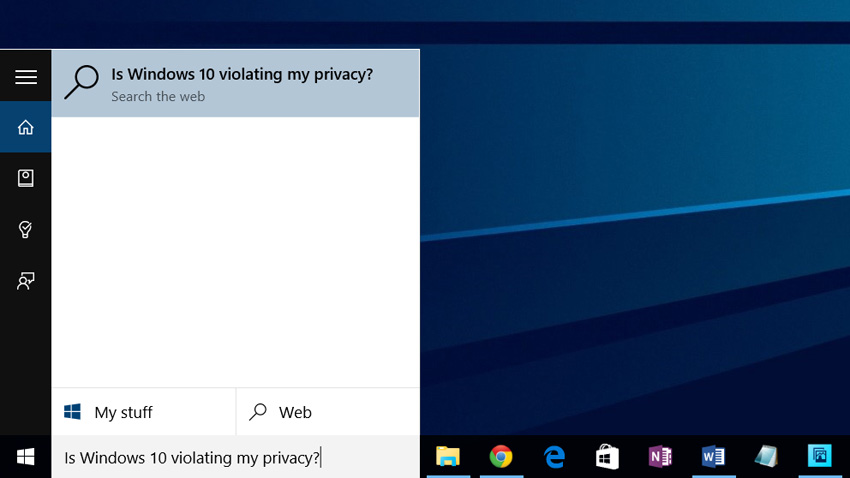Windows 10 Privacy Concerns Are Overblown, But Perception Matters
With overwhelmingly positive reviews and tens of millions of successful upgrades in its first week, Windows 10 is off to a great start. But Microsoft has also been dealing with a number of complaints about the new system. And while most of these complaints are bogus, growing concerns about the apparent privacy violations in Windows 10 could cause lasting damage.
Most of the complaints fall into two basic categories, those things that are in fact not new to Windows 10, and those things are really new but are being overblown by privacy fanatics. Regardless, these reports are tugging at our very human tendency to see conspiracy where there is none: Windows 10 is free for many, so Microsoft simply must be doing something underhanded as a result. After all, Microsoft would never really give away Windows 10 for free.
Wake up, people.
Let’s examine some of the more common complaints.
Most settings in Windows—browser history, favorites, and passwords—are now automatically synchronized to Microsoft’s servers. This isn’t new, as it debuted in Windows 8. It’s also not automatic: you need to sign-in with a Microsoft account for this to happen, and then choose Express Settings, bypassing options where you decide what syncs. And one of the key advantages of signing in with a Microsoft account is—wait for it—that most settings in Windows are now automatically synchronized between your PCs and devices.
Cortana collects even more data for Microsoft, including a device’s location, calendar data, app usage, emails, text messages, and phone call history. It sure does. When you enable Cortana and opt-in to this behavior. By default, Cortana doesn’t do anything except search your PC and the web for information you request. And Cortana won’t even respond to voice commands until you navigate into its UI to enable this feature. Which you must do manually. And what does that “for Microsoft” bit even mean? Cortana does this “for you.” You know, when you ask her too.
Windows 10’s new feature steals your Internet bandwidth. The claim here is that “a devious little feature called Windows Update Delivery Optimization [is] enabled by default [and] Microsoft can send home type users’ data update goodies to potentially any PC on the global Internet — from your PC, over your Internet connection. On your dime.” This one is sensationally worded but is actually true: Windows 10 is designed to use peer to peer networking technology to reduce bandwidth so that a home or office with multiple PCs can download updates only once from the Internet and then share those updates locally with the other PCs. (If you’re familiar with how BranchCache works in Windows Server, this is the client version.) You can turn it off. But if you’re using a metered connection (as with a cellular provider, where you pay by the megabyte, it’s off by default.
Microsoft assigns a unique advertising ID for each [Windows 10 PC] and Bing which collects data which is then sold to third parties to provide users with more personalized search results. This debuted in Windows 8, is anonymous, and can be disabled.
A new feature called Wi-Fi Sense actually shares your protected Wi-Fi passwords with your friends. No, it doesn’t. This feature, which actually debuted last year in Windows Phone 8.1, allows you to determine whether you want to share Wi-Fi login information with your contacts the first time you sign-in to that network only. You have to opt-in, and you can determine which friends from which accounts receive this information. They must be using Windows 10 (or Windows Phone 8.1). And the actual passwords are never in fact given to your friends; their devices just sign-in automatically.
Kirsten Fiedler of the European Digital Rights told the UK’s Mail that “Microsoft basically grants itself the right to collect and process everything you do, say and write on your device – which is contrary to the fundamental right to privacy.”
Sigh.
That’s insane. But the issue here is that reality often trails perception, and that perception can ruin the reputation of a product like Windows 10 as well as the company that makes it. To this end, Microsoft will need to make some changes to Windows 10 that either make what’s happening more obvious or, more likely, actually de-tune some of these supposed privacy violations. This will in turn “prove” to the privacy nuts that they were right and, worse, will make Windows 10 harder to use for the regular people who are in fact benefiting from this functionality.
Which is too bad. Those who care about privacy are free to configure the system as they please. I wish they’d just stop messing with the truth.




